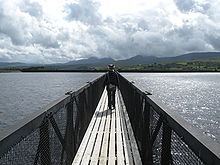OS grid reference SH707356 Country Wales Population 973 (2011) Dialling code 01766 | Community Trawsfynydd Sovereign state United Kingdom Local time Tuesday 10:11 PM Postcode district LL41 | |
 | ||
Weather 5°C, Wind NW at 3 km/h, 85% Humidity | ||
Trawsfynydd ([trausˈvənɨ̞ð]; Welsh for "across [the] mountain") is a village in Gwynedd, Wales, adjacent to the A470 north of Bronaber and Dolgellau near Blaenau Ffestiniog.
Contents
- Map of Trawsfynydd Blaenau Ffestiniog UK
- General information
- Governance
- Llyn Trawsfynydd and power stations
- Hedd Wyn
- Church of St Madryn
- In popular culture
- Notable people
- References
Map of Trawsfynydd, Blaenau Ffestiniog, UK
The total parish area is 12,830 hectares with a population of just under 1000, measured at 973 in the 2011 Census – the area is sparsely populated with each hectare inhabited by an average 0.07 persons. The village is typical of many Welsh villages. There is one grocery shop, one public house, a newsagent, a chemist, garage, petrol service station, and a branch of a large agricultural merchants.
General information
During the Second World War, the War Office used a site near Trawsfynydd for training exercises. Its continued use for training exercises following the war was the subject of protest by Plaid Cymru, which also challenged the UK government's continued military conscription in peace time. Other locations in Wales used for training exercises included the Preseli Hills, Bronaber, and Tregaron.
Trawsfynydd used to be served by a section of the Great Western Railway branch line, which ran from Bala to Blaenau Ffestiniog. To the north of the station, the army built its own station to serve the large camp nearby.(camp detail) Today Trawsfynydd railway station is a private home. (pictures). The line closed to all traffic in 1961, and the trackbed at the Bala end was subsequently severed by the Llyn Celyn reservoir, but the section between Blaenau and Trawsfynydd Power Station reopened in 1964 for nuclear flask traffic. Access from the Bala end being no longer possible, a new section of track – the so-called "Trawsfynydd Link" – was constructed to link the previously separate ex-GWR and ex-LNWR stations in Blaenau Ffestiniog. It finally closed in 1998, although the track remains in situ.
The village has a high proportion of Welsh language speakers (81.7%), and is accordingly in the top five Welsh-speaking communities in Gwynedd.
Governance
An electoral ward in the same name exists. This ward includes the community of Maentwrog and has a total population of 1,604.
Llyn Trawsfynydd, and power stations
The village is close to Llyn Trawsfynydd, a large man-made reservoir, which was originally built between 1924 and 1928 to supply water for Maentwrog hydro-electric power station.
The original flooding of the area in the 1920s to create the lake involved the drowning of some two dozen properties, some of historical significance, but there was little objection at the time. The new power station was regarded as a good thing, and indeed on its completion was capable of supplying the whole of North Wales' electricity needs.
However, there was certain objection to the loss of rights of way across the former land, necessitating long detours round the new lake. In response to this, a small road was built along its western shore, and a footbridge (still standing) across the narrowest part of the lake.
The lake was subsequently also supplied cooling water to the twin reactor Trawsfynydd nuclear power station used for the commercial generation of electricity for the UK national grid.
Four dams were built to create the lake, one of these being subsequently rebuilt after construction of the nuclear power plant. Whereas previously the Maentwrog power station had access to all of the water in the lake, the needs of the nuclear plant dictated that from then on, the hydro plant should only use the top five feet of water.
Hedd Wyn
Trawsfynydd was the home of the Welsh bard Hedd Wyn, who died on the battlefields of Flanders during World War I, just before he was to receive the winning prize at the National Eisteddfod. Y Gadair Ddu (The Black Chair) can now be found at his home farm Yr Ysgwrn. He is buried in Flanders.
Church of St Madryn
The church is dedicated to St Madryn, was burned down in 1978 and re-opened in 1981 (it remains the only listed building in the village).
The parish of Trawsfynydd was home to Saint John Roberts, one of the Forty Martyrs of England and Wales, canonised in 1970: he was baptised in the church. Descended from Welsh saints and princes, he gained great respect helping the plague sufferers in London, but was found guilty of high treason and hanged, drawn and quartered on 10 December 1610.
In popular culture
In 1976 the Children's Film Foundation production One Hour to Zero was filmed in the village and at the nearby power station. The film First Knight had scenes filmed around Lake Trawsfynydd.
The film Hedd Wyn was filmed in and around Trawsfynydd.
